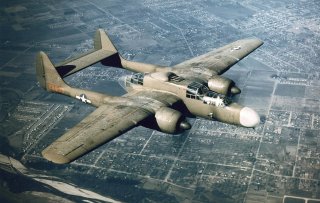The P-61 Black Widow Could Have Been a Killer Night Fighter
Unfortunately, it entered service too late in World War II to play a significant role.
The P-61’s origins begin with the British, who submitted a design request to the United States for a powerful night fighter that would have a high service ceiling, long eight-hour plus loiter time, as well as a powerful climb capability. The result of that design request was the P-61 Widow, an unusual twin-engine airplane that holds the distinction of being the first American warplane designed from the outset as a night fighter, and the first fighter to be equipped with onboard radar.
The airplane’s design is immediately noticeable: unlike many contemporary airplanes, the P-61’s fuselage forms a kind of central cockpit gondola, mated to the airframe’s straight wings, but seemingly suspended in the middle of the aircraft, with twin booms rear of the engines extend rearward and form a connected tail assembly.
Aside from the unusual fuselage design, what made the P-61 truly unique was its onboard radar.
The British made good use of an early radar system to defend their island from the Nazi German Luftwaffe during the Battle of Britain. Ground-based radar systems were able to detect incoming Luftwaffe bombers and direct British fighters towards enemy bomber formations, even at night or during bad weather.
The P-61’s designers put a new (and much smaller) radar unit inside the fighter jet’s rather elongated nose. Though vastly underpowered by today’s radar standards, the P-61’s radar had a nearly five-mile range and was operated by the fighter’s sole radar operator who guided the pilot towards the target verbally. Once the pilot had a visual on the enemy planes, he used a separate spotting scope to bring the twin-engined fighter toward the enemy planes.
The P-61jet was a powerfully armed fighter, with four forward-facing 20-millimeter cannons mounted in the airplane’s fuselage, as well as four .50 heavy machine guns mounted on a remotely operated turret on top of the fuselage. The P-61 also had a limited ground attack capability via hardpoints under the wings, though it was not a dedicated ground attack airplane.
Though the P-61 jet and associated aircraft variants did not enjoy as much success as some of the war’s other better-known fighter aircraft, one P-61 variant, Northrop’s F-15 Reporter, did see service during the Korean War as one of the United States’ only early photo-reconnaissance aircraft. During the war’s early stages, the Japan-based aircraft photographed parts of the Korean Peninsula, providing an invaluable source of photographic mapping for the United States and the United Nations Allies.
Though the P-61 jet was a solid night fighter, capable of engaging virtually all German and Japanese aircraft it came against, even though the design came too late in the war to have a significant effect on the conflict. Still, the Black Widow makes for an interesting, if decidedly odd-looking, piece of World War II history.
Caleb Larson is a Defense Writer with The National Interest. He holds a Master of Public Policy and covers U.S. and Russian security, European defense issues, and German politics and culture.
Image: Wikimedia Commons

